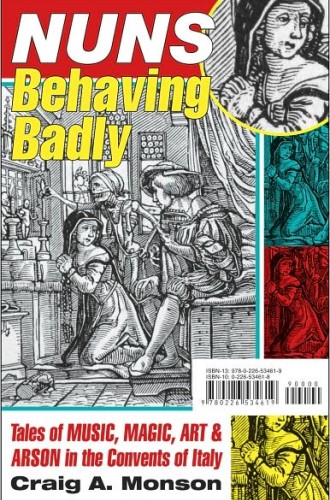Nuns Behaving Badly, by Craig A. Monson
Music historian Craig Monson had the rare privilege of doing research in the Vatican Archive reading room. That collection isn't indexed, and the archivists apparently are not eager to help with anything besides fetching books from the library, so researchers usually have to pore over lots of material before finding what they're after. As he searched for references to composers he was studying, Monson kept stumbling across disciplinary reports on errant nuns. He found these intriguing and decided that they would make an interesting research topic of their own.
In the resulting book, Nuns Behaving Badly, Monson tells of five different convent scandals in Renaissance Italy. They all follow the same pattern: a few nuns break the rules, the prioress covers it up, eventually word gets out, an archbishop comes to the convent and interviews everyone involved, and the nuns are disciplined. In one story, a group of nuns set their convent on fire in order to escape. In another, a young nun sneaked out at night dressed as a man to attend the city's carnival. Evidence of these incidents is primarily found in the reports the archbishop had to send in about his interviews and disciplinary decisions.
Read our latest issue or browse back issues.
We are meant to be thrilled by these escapades, pleasantly shocked at the idea of cloistered women being rebellious. Monson completely undermines this effect in his own prologue, however, when he explains that personal devotion had little to do with entering a convent at the time. Renaissance Italy was experiencing dowry inflation, and many families could put aside enough money to marry off only one of their daughters. The rest were sent to convents, many against their will. Convents were also magnets for reformed prostitutes and fallen women. One can hardly expect this flock to have been docile.
Monson almost never mentions a nun who joined a convent willingly. When one prioress was asked whether one of the misbehavers had wanted to be a nun, she said that on the day the nun came to the convent she "repeatedly clamped down on her throat to choke herself—squeezing her throat repeatedly in desperation, trying to strangle herself, because she never wanted to come here. Then, as we proceeded through the streets to this convent, she continued to cry out and weep."
Another nun talked constantly of escaping, and when two visitors came to the convent she announced her plan to leap into their carriage as they drove away. When the nuns gathered outside to bid the visitors farewell, "the prioress surreptitiously tied [the nun's] habit to the chain on the gate. When Mogna tried to dart out after the departing carriage, her habit nearly throttled her, giving the other nuns time to hold her back."
Although painstakingly researched and lightly told, Monson's stories rely on the very shock value that he explains away in the prologue. He often rolls his eyes at the reactions of the archbishops, who were flabbergasted to encounter independent-minded women. It's unclear whether Monson realizes that he's guilty of the same mistake.







